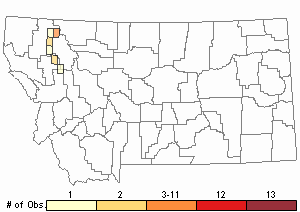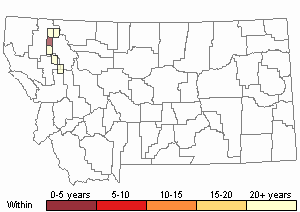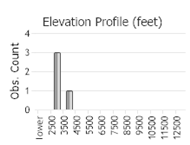View in other NatureServe Network Field Guides
NatureServe
Montana
Utah
Wyoming
Idaho
Wisconsin
British Columbia
South Carolina
Yukon
California
New York
Hair Silk Moss - Plagiothecium piliferum
General Description
Plants: Pleurocarpous, growing in thick mats, pale green to somewhat yellow, shiny (FNA 2014). Stems and branches creeping (Lawton 1971), to 6 cm in length, with leaves flattened into one plane to somewhat appressed and overlapping, giving the stem a near catkin-like appearance; pseudoparaphyllia wanting (FNA 2014).
Leaves: Upright, flattened next to the stem and overlapping, similar in wet and dry conditions, symmetrical, not pleated, cupped (FNA 2014), not wavy (Lawton 1971), 0.8-2 mm in length, to 0.8 mm in width, egg-shaped and somewhat oblong, with a sudden narrowing of the apex to form the acumen, the acumen long, thread-like, bent and twisted; base extending down the stem (FNA 2014), the decurrencies deltoid in profile (Lawton 1971); leaf edges with a slender portion curved back and downward for much of the leaf length (not quite to the apex), smooth or very finely saw-toothed at the apex; costa scarcely exceeding the leaf bottom, or costa absent. Branch leaves akin to stem leaves (FNA 2014).
Leaf Cells: Cells of the lamina smooth; basal cells of the lamina with walls pitted (Lawton 1971), wider and not as long as the medial cells; medial cells linear or linear and very narrowly diamond-shaped, sometimes slightly bent, usually longer than the apical cells, containing a lot of chlorophyll; alar cells oblong, arranged in 2 to 4 longitudinal rows and ending in a single cell at the leaf bottom, the alar area deltoid (FNA 2014).
Phenology
Fruit ripens in the springtime and in summer (FNA 2014).
Diagnostic Characteristics
The suddenly narrowed leaf apex with the thread-like, twisting acumen, which occasionally reaches a length 1/3 that of the leaf, is one of the notable characteristics of this species (FNA 2014).
Range Comments
North American Range
Canada: NT, BC, and QC; USA: AK, WA to CA, ID, and MT (FNA 2014). Known in Montana from Flathead, Glacier, and Lake Counties (Elliott and Pipp 2016).
Observations in Montana Natural Heritage Program Database
Number of Observations: 18
(Click on the following maps and charts to see full sized version)
Map Help and Descriptions
Relative Density

Recency



 (Observations spanning multiple months or years are excluded from time charts)
(Observations spanning multiple months or years are excluded from time charts)
Habitat
In evergreen woods on trees (FNA 2014) and moist to wet decaying wood, stones (Elliott and Pipp 2016) and bluffs, favoring somewhat acidic habitats. Occurring from lowlands to about 4920 feet elevation (FNA 2014).
Reproductive Characteristics
Autoicous, typically producing sporophytes. Perigonia and perichaetia numerous at stem bottoms. Seta 8-15 mm tall, spiraled, smooth, yellow or sometimes red. Capsule upright or tilting a little, not bowed, pale- to yellow- brown (FNA 2014) or russet (Lawton 1971) when well-developed, to 4 mm in length, smooth or a little creased when dry, very creased at the neck (FNA 2014), typically constricted below the opening (Lawton 1971); operculum to 0.7 mm, cone-shaped; exostome teeth with fine, transverse ridges below on the outer surface and papillae above; endostome processes keeled; cilia typically lacking, or occasionally 1 or 2, scarcely developed. Calyptra draping hood-like, hairless, falling away easily (FNA 2014).
Stewardship Responsibility
References
- Literature Cited AboveLegend:
 View Online Publication
View Online Publication Elliott, J.C. and A.K. Pipp. 2018. A Checklist of Montana Mosses (1880-2018). Updated 3 January, 2020. Montana Natural Heritage Program, Helena, Montana. 73 pp.
Elliott, J.C. and A.K. Pipp. 2018. A Checklist of Montana Mosses (1880-2018). Updated 3 January, 2020. Montana Natural Heritage Program, Helena, Montana. 73 pp. Flora of North America Editorial Committee, eds. 2014. Flora of North America North of Mexico. Volume 28. Bryophytes: Mosses, Part 2. Oxford University Press, Inc., NY. xxi + 702 pp.
Flora of North America Editorial Committee, eds. 2014. Flora of North America North of Mexico. Volume 28. Bryophytes: Mosses, Part 2. Oxford University Press, Inc., NY. xxi + 702 pp. Lawton, E. 1971. Moss Flora of the Pacific Northwest. Hattori Botanical Laboratory. Japan: Yamabuki-cho, Shinjuku-ku, Tokyo. 362 pages plus appendices.
Lawton, E. 1971. Moss Flora of the Pacific Northwest. Hattori Botanical Laboratory. Japan: Yamabuki-cho, Shinjuku-ku, Tokyo. 362 pages plus appendices.
- Additional ReferencesLegend:
 View Online Publication
View Online Publication
Do you know of a citation we're missing? Elliot, J. C. 1993. Second checklist of Montana mosses. Unpublished report. U.S. Forest Service, Region 1. Missoula, MT. 45 pp.
Elliot, J. C. 1993. Second checklist of Montana mosses. Unpublished report. U.S. Forest Service, Region 1. Missoula, MT. 45 pp. Lawton, E. 1971. Keys for the Identification of the Mosses on the Pacific Northwest. Reprinted from 'Moss Flora of the Pacific Northwest'. Published as Supplement No. 2 of the Journal of the Hattori Botanical Laboratory. Nichinan, Miyazaki, Japan. 66 pp.
Lawton, E. 1971. Keys for the Identification of the Mosses on the Pacific Northwest. Reprinted from 'Moss Flora of the Pacific Northwest'. Published as Supplement No. 2 of the Journal of the Hattori Botanical Laboratory. Nichinan, Miyazaki, Japan. 66 pp. Malcolm, B., N. Malcolm, J. Shevock, and D. Norris. 2009. California Mosses. Nelson, New Zealand: Micro-Optics Press. 430 pp.
Malcolm, B., N. Malcolm, J. Shevock, and D. Norris. 2009. California Mosses. Nelson, New Zealand: Micro-Optics Press. 430 pp. Smith, A.J.E. 1980. The Moss Flora of Britain and Ireland. Cambridge University Press, Cambridge. 705 pp.
Smith, A.J.E. 1980. The Moss Flora of Britain and Ireland. Cambridge University Press, Cambridge. 705 pp.
- Web Search Engines for Articles on "Hair Silk Moss"





